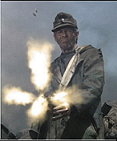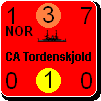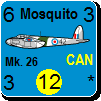waltero
Posts: 202
Joined: 1/24/2008
From: Alaska
Status: offline

|
The Documentary of Lobo.
The TV Documentary was heartbreaking.
Lobo was an American wolf who lived in the Currumpaw valley[ in New Mexico. During the 1890s, Lobo and his pack, having been deprived of their natural prey by settlers, turned to the settlers' livestock. The ranchers[ tried to kill Lobo and his pack by poisoning carcasses, but the wolves removed the poisoned pieces and threw them aside. They tried to kill the wolves with traps and by hunting parties but these efforts also failed. Ernest Thompson Seton was tempted by the challenge and the alleged $1,000 bounty for capturing Lobo, the leader of the pack. Seton tried poisoning five baits, carefully covering traces of human scent, and setting them out in Lobo's territory. The following day all the baits were gone, and Seton assumed Lobo would be dead. Later, however, he found the five baits all in a pile covered in other "evidence" for which Lobo was responsible.
Seton bought new, specialized traps and carefully concealed them in Lobo's territory, but he later found Lobo's tracks leading from trap to trap, exposing each. When an effort that was initially supposed to take two weeks stretched into months of failed attempts to capture Lobo, Seton became tired and frustrated. While camping out above the creek where snow geese and cranes were wintering, he found Lobo's track strangely following a set of smaller tracks. Quickly he realized Lobo's weakness: his mate, a white wolf named Blanca. Seton then set out several traps in a narrow passage thinking Blanca would fall for Seton's planted baits that Lobo had thus far managed to avoid. Finally Seton succeeded; Blanca, while trying to investigate Seton's planted cattle head, became trapped. When Seton found her, she was howling with Lobo by her side. Lobo ran to a safe distance and watched Seton and his men kill Blanca by breaking her neck with ropes tied to their horses. Seton heard the howls of Lobo for days afterward. Lobo's calls were described by Seton as having "an unmistakable note of sorrow in it... It was no longer the loud, defiant howl, but a long, plaintive wail." Although Seton felt remorse for the grieving wolf, he continued his plan to capture Lobo.
Despite the danger, Lobo followed Blanca's scent to Seton's ranch house where they had taken the body. Seton then set more traps, using Blanca's body to scent them. On January 31, 1894, Lobo was caught, with each of his four legs clutched in a trap. On Seton's approach, Lobo stood despite his injuries, and howled. Touched by Lobo's bravery and loyalty to his mate, Seton could not kill him. He and his men roped Lobo, muzzled him and secured him to a horse, taking him back to the ranch. Lobo refused to acknowledge his captors; they secured him with a chain and he just gazed across the prairie. Lobo died that night without any apparent cause, although Seton knew he died of a broken heart.
Lobo's pelt is kept at the Ernest Thompson Seton Memorial Library and Museum at the Philmont Scout Ranch near Cimarron, New Mexico. Until his death in 1946, Seton championed the wolf—an animal that had always previously been demonized. "Ever since Lobo", Seton later wrote, "my sincerest wish has been to impress upon people that each of our native wild creatures is in itself a precious heritage that we have no right to destroy or put beyond the reach of our children."
Seton's story of Lobo touched the hearts of many both in the US and the rest of the world and was partly responsible for changing views towards the environment and provided a spur for the starting of the conservationist movement. The story had a profound influence on one of the world's most acclaimed broadcasters and naturalists Sir David Attenborough and inspired the 1962 Disney film, The Legend of Lobo. Lobo's story was the subject of a BBC documentary directed by Steve Gooder in 2007.
An account of Seton's hunt for Lobo is found in Ernest Thompson Seton: The Life and Legacy of an Artist and Conservationist by David L. Witt. It is based on Seton's personal journal and other historical sources. The story is also featured in an exhibition at the New Mexico History Museum running from May 23, 2010 to May 8, 2012
< Message edited by waltero -- 12/24/2015 5:22:41 PM >
|
 Printable Version
Printable Version














 Clara, why did you leave us?..... Can't they have a 'Dallas' type shower situation - and it turns out it was all a dream and you're not really dead?
Clara, why did you leave us?..... Can't they have a 'Dallas' type shower situation - and it turns out it was all a dream and you're not really dead? 








 New Messages
New Messages No New Messages
No New Messages Hot Topic w/ New Messages
Hot Topic w/ New Messages Hot Topic w/o New Messages
Hot Topic w/o New Messages Locked w/ New Messages
Locked w/ New Messages Locked w/o New Messages
Locked w/o New Messages Post New Thread
Post New Thread